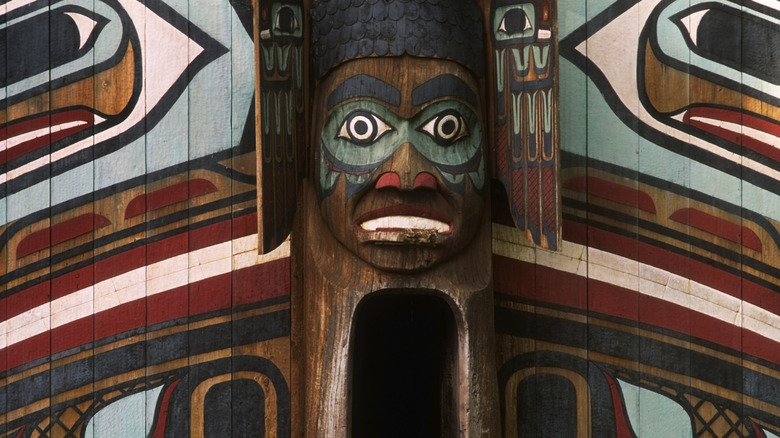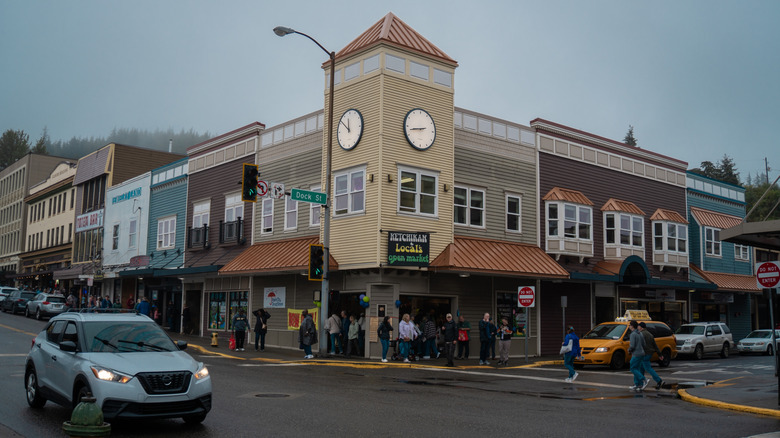A Stately Coastal Preserve Protects Native Traditions Amongst The Wild Beauty Of Alaska
There's no better place to discover the craftsmanship behind totem poles — towering wooden structures adorned with intricate animal and human carvings — than in Totem Bight State Historical Park. Nestled 10 miles north of Ketchikan, Alaska, also known as the Salmon Capital of the World, the park offers visitors a rare opportunity to connect with the heritage of Alaska's Native peoples. Here, a stunning array of totem poles brings Tlingit and Haida artistry vividly to life. These "silent storytellers" stand ready to help visitors unlock the rich history and traditions that have defined the region.
A little bit of history: In the early 1900s, the Native communities left Totem Bight to look for job opportunities somewhere else. This, in turn, threatened to erase their legacy as decay took over the totem poles and structures they had left. However, a revival for this heritage site began in the 1930s, with the U.S. Forest Service and Civilian Conservation Corps undertaking a determined revival of the site. This dedication saw Alaska take ownership in 1959, followed by Totem Bight earning its place on the National Register of Historic Places in 1970.
Discover Totem Bight State Historical Park
At the heart of the park is the Clan House, which is a carefully constructed replica of a traditional chieftain's dwelling that could accommodate up to 50 people. It features a central fireplace, a planked platform, hand-adzed walls and floors, and carved house posts that show a detailed look into the living practices from the past of Alaska's Indigenous communities. Visitors shouldn't feel overwhelmed about understanding the stories behind the totem poles, as there's a handy brochure from the State of Alaska Department of Natural Resources that one can download, explaining the park's historical and cultural significance.
Guided tours at Totem Bight State Historical Park offer visitors a structured and informative way to learn about the significance of the totem poles and the Clan House. While paid and guided tours are available, plenty of visitors advise on Tripadvisor that it's better to explore the park solo. With clear paths, accessible interpretive trails, and a brochure that explains the stories behind the 14 totem poles, it's easy to navigate and enjoy the park at one's own pace. For those who want to further support the park and give thanks to rangers, feel free to leave a donation, especially since the $5 entrance fee is waived during the off-season.
Getting to Totem Bight and dining in Ketchikan
Ketchikan would be your Totem Bight hub, and it's highlighted as one of the rewarding, off-the-beaten-path destinations along Alaska's cruise routes. You could fly into Ketchikan International Airport (KTN) and from there, either rent a car or take public transit. The most convenient and budget-friendly way to reach the park is by taking the Blue Line city bus operated by the Ketchikan Gateway Borough. This direct bus service departs hourly from Front Street at Dock Street near Berth 2, with the ride to North Tongass Highway and D-1 Loop South taking roughly 25 minutes and costing just $2 to $3, at the time of this writing.
If you're planning to have a picnic while at Totem Bight State Historical Park, try to first grab a meal from one of Ketchikan's local favorites. The Alaska Fish House is renowned for its fresh seafood, especially the halibut and chips described as "crispy, tender, and unforgettable," according to a review on Google, while another reviewer praised Island Brew Cafe for its pastries and hearty lunches, with their scones and ginger chews earning "borderline lifechanging" acclaim. Enjoy your food at the picnic shelter and scenic viewing deck at Totem Bight State Historical Park. This is a perfect spot to relax and take in the sweeping views of the Tongass Narrows, where bald eagles, orcas, humpback whales, and other wildlife can often be seen.


